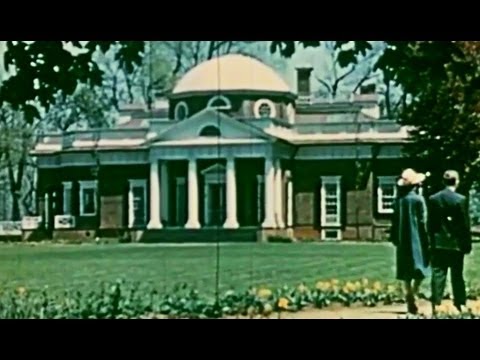more at
Focuses on the area where Thomas Jefferson and James Monroe grew up.
Public domain film from the Prelinger Archive, slightly cropped to remove uneven edges, with the aspect ratio corrected, and mild video noise reduction applied.
The soundtrack was also processed with volume normalization, noise reduction, clipping reduction, and/or equalization (the resulting sound, though not perfect, is far less noisy than the original).
Thomas Jefferson (April 13, 1743 (April 2, 1743 O.S.) — July 4, 1826) was an American Founding Father, the principal author of the Declaration of Independence (1776) and the third President of the United States (1801–1809). At the beginning of the American Revolution, he served in the Continental Congress, representing Virginia and then served as a wartime Governor of Virginia (1779–1781). Just after the war ended, from mid-1784 Jefferson served as a diplomat, stationed in Paris. In May 1785, he became the United States Minister to France.
Jefferson was the first United States Secretary of State (1790–1793) serving under President George Washington. With his close friend James Madison he organized the Democratic-Republican Party, and subsequently resigned from Washington’s cabinet. Elected Vice President in 1796, when he came in second to John Adams of the Federalists, Jefferson opposed Adams and with Madison secretly wrote the Kentucky and Virginia Resolutions, which attempted to nullify the Alien and Sedition Acts.
Elected president in what Jefferson called the Revolution of 1800, he oversaw the purchase of the vast Louisiana Territory from France (1803), and sent the Lewis and Clark Expedition (1804–1806) to explore the new west…
Monticello is the primary plantation of Thomas Jefferson, the third President of the United States, who, after inheriting quite a large amount of land from his father, started building Monticello when he was twenty-six years old. Located just outside Charlottesville, Virginia, in the Piedmont region, the plantation was originally 5,000 acres, with extensive cultivation of tobacco and mixed crops, with labor by slaves. What started as a mainly tobacco plantation switched over to a wheat plantation later in Jefferson’s life. At Jefferson’s direction, he was buried on the grounds, an area now designated as the Monticello Cemetery, which is owned by the Monticello Association, a lineage society of his descendants through Martha Wayles Skelton Jefferson.
The house, which Jefferson designed, was based on the neoclassical principles described in the books of the Italian Renaissance architect Andrea Palladio. He reworked it through much of his presidency to include design elements popular in late eighteenth-century Europe. It contains many of his own design solutions…
James Monroe (April 28, 1758 — July 4, 1831) was the fifth President of the United States (1817–1825). Monroe was the last president who was a Founding Father of the United States, the third of them to die on Independence Day, and the last president from the Virginia dynasty and the Republican Generation. He was of French and Scottish descent. Born in Westmoreland County, Virginia, Monroe was of the planter class and fought in the American Revolutionary War. He was injured in the Battle of Trenton with a musket ball to his shoulder. After studying law under Thomas Jefferson from 1780 to 1783, he served as a delegate in the Continental Congress. As an anti-federalist delegate to the Virginia convention that considered ratification of the United States Constitution, Monroe opposed ratification, claiming it gave too much power to the central government. He took an active part in the new government, and in 1790 he was elected to the Senate of the first United States Congress, where he joined the Jeffersonians. He gained experience as an executive as the Governor of Virginia and rose to national prominence as a diplomat in France, when he helped negotiate the Louisiana Purchase in 1803. During the War of 1812, Monroe held the critical roles of Secretary of State and the Secretary of War under President James Madison.
Facing little opposition from the fractured Federalist Party, Monroe was easily elected president in 1816, winning over 80 percent of the electoral vote and becoming the last president during the First Party System era of American politics. As president, he bought Florida from Spain and sought to ease partisan tensions, embarking on a tour of the country that was generally well received…

